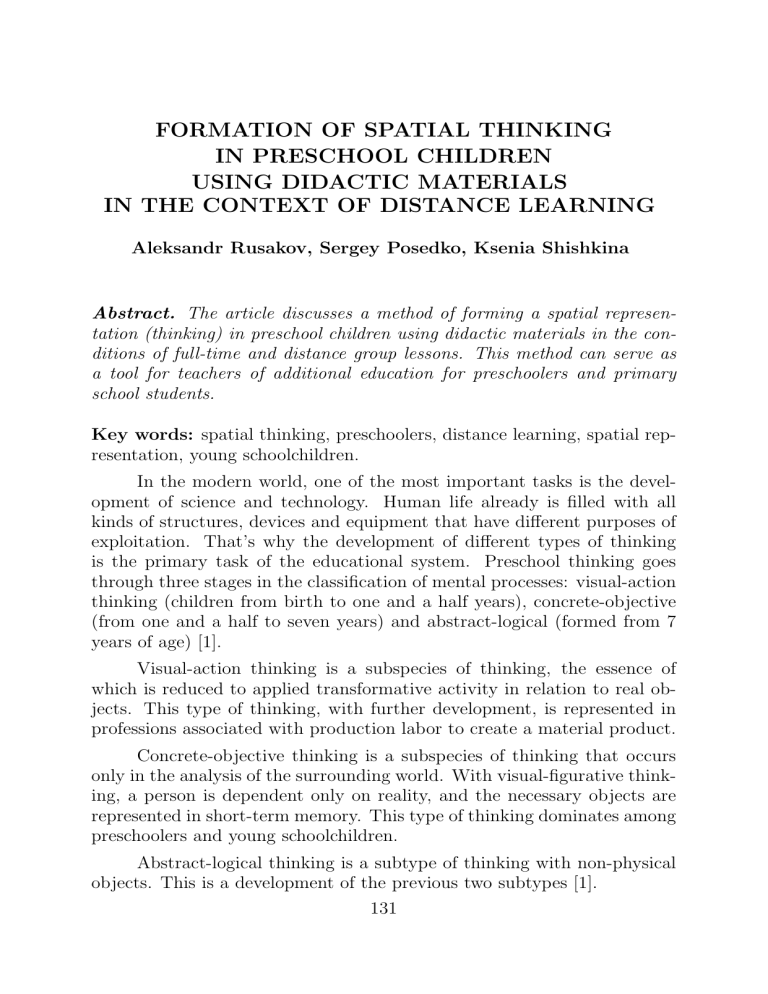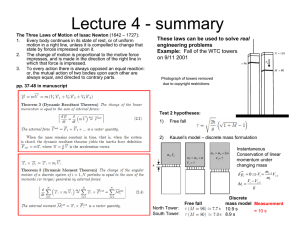
FORMATION OF SPATIAL THINKING IN PRESCHOOL CHILDREN USING DIDACTIC MATERIALS IN THE CONTEXT OF DISTANCE LEARNING Aleksandr Rusakov, Sergey Posedko, Ksenia Shishkina Abstract. The article discusses a method of forming a spatial representation (thinking) in preschool children using didactic materials in the conditions of full-time and distance group lessons. This method can serve as a tool for teachers of additional education for preschoolers and primary school students. Key words: spatial thinking, preschoolers, distance learning, spatial representation, young schoolchildren. In the modern world, one of the most important tasks is the development of science and technology. Human life already is filled with all kinds of structures, devices and equipment that have different purposes of exploitation. That’s why the development of different types of thinking is the primary task of the educational system. Preschool thinking goes through three stages in the classification of mental processes: visual-action thinking (children from birth to one and a half years), concrete-objective (from one and a half to seven years) and abstract-logical (formed from 7 years of age) [1]. Visual-action thinking is a subspecies of thinking, the essence of which is reduced to applied transformative activity in relation to real objects. This type of thinking, with further development, is represented in professions associated with production labor to create a material product. Concrete-objective thinking is a subspecies of thinking that occurs only in the analysis of the surrounding world. With visual-figurative thinking, a person is dependent only on reality, and the necessary objects are represented in short-term memory. This type of thinking dominates among preschoolers and young schoolchildren. Abstract-logical thinking is a subtype of thinking with non-physical objects. This is a development of the previous two subtypes [1]. 131 October 22–24, 2021, Plovdiv, Bulgaria Mastery of the ultimate spatial thinking is essential for the child to obtain full information about the world, analyse it and draw the right conclusions. Kindergartens are now equipped with everything necessary to develop the spatial orientation of pre-school children. Examples of such didactic materials include: • Nikitin cubes; • construction set “Plashki”; • details for the board game “Tower Tomik”. Consider an example of using the above materials in kindergarten classes. There are several directions within which it is possible to conduct games that develop spatial thinking so that children do not lose interest and, imperceptibly for themselves, improve the skills already acquired. The directions described below will help not only to develop spatial orientation, but also to help understand how abstract knowledge can be used in real life. Let us single out two areas that we will talk about: drawing (image of a visual impression) and constructing (an applied problem for transferring visual experience to practical). Drawing in kindergarten is the main source of both the child’s impressions themselves and the reflection of his or her attitude to the world. Head of the Department of Aesthetic Education, Sholokhov Moscow State University for Humanities, Honored Worker of Science of the Russian Federation, Doctor of Pedagogical Sciences, Professor, Full Member of the International Academy of Sciences of Pedagogical Education, Tamara Semenovna Komarova, a leading specialist in pre-school education, writes in her manual for artistic activities in kindergarten for senior groups, that the development of talents and abilities of preschoolers is based on direct experience of perception of the environment [2]. T.S. Semenova says that any child’s activities planned by a teacher in a preschool institution should be integrated. What does it mean? Drawing, modeling, construction, etc. should be related to each other. Thus, it is necessary to combine and, for example, design (or drawing) and the development of different types of thinking. Next, we will talk about a specific type of activity that allows to de132 Anniversary International Scientific Conference REMIA’2021 velop spatial thinking in preschool children using didactic materials, which were mentioned above: Nikitin cubes, construction set “Plashki” and details for the board game “Tower Tomik”. Thus, classes are built on the basis of three sets of materials and two directions: the image (drawing) by the child for a specific task and the construction of any structure. It is important to mention that within one lesson it is necessary to have levels of difficulty of the game so that for each child there is a very easy and tangibly difficult task. It is important, from class to class, to alternate sets (props) and directions of classes. If one activity with a drawing direction, then the second with a construction. The method described below for the formation of spatial thinking in preschool children is actively used in the Budgetary Educational Institution School No. 1454 of Moscow “Timiryazevskaya” in full-time and distance group lessons. It is proposed to distribute the levels of construction tasks (towers) from the materials presented in Table 1. Level number 1 2 3 4 5 6 Description Build by example Build by 3D card Build by card in front view Build by card from top view Build by card in front and top view Build by card in three projections Table 1. Construction complexity levels Description of levels from the table: 1. Build by example. The teacher builds a tower in front of the children and invites them to build the same one by example. It is assumed that children can freely inspect the tower from all sides they need. 2. Build by 3D card. The child is asked to build a tower using the 3D image on the card (Figure 1). 3. Build by card in front view. At this level, the child receives a card with a 2D image of a tower (Figure 2) and builds a tower, which has a front view of the image on the card. 133 October 22–24, 2021, Plovdiv, Bulgaria 4. Build by card from top view. At this level, the child receives a card with a 2D tower image and builds a tower, which has a top view of the image on the card. 5. Build by card in front and top view. At this level, the child receives a card with two 2D images of the tower and builds a tower with the images on the card – front and top view. 6. Build by card in three projections. The child has a card that shows three projections of one tower. The task is to build it so that it coincides with the one depicted on the card from three sides. Figure 1. Example of a card with a 3D image Figure 2. An example of a card with a front view The level distributions for the drawing direction are presented in Table 2. Level number 1 2 3 4 Description Draw a view from front Draw a view from top Draw a view from front and top Draw three projections Table 2. Difficulty levels for drawing views (projections) Description of levels: 1. Draw a view from front. The teacher builds 6 towers. The children have a sheet with the outlines of the towers depicted (Figure 3). 134 Anniversary International Scientific Conference REMIA’2021 The child’s task is to find the outline that corresponds to the front view of this tower and color it. 2. Draw a view from top. The teacher builds towers. The children have a sheet with the outlines of the towers depicted (Figure 3). The child’s task is to find and correctly color the contour that corresponds to the top view of this tower. 3. Draw a view from front and top. The teacher builds towers. The children have a sheet with the outlines of the towers depicted, the child’s task is to find and correctly color those outlines that correspond to the front and top view of this tower. 4. Draw three projections. The teacher builds towers, the children have a sheet with the outlines of the towers depicted, the child’s task is to find and correctly color those outlines that correspond to the three projections of this tower. Figure 3. An example of a child’s sheet with front views of the towers Thus, alternating classes in these two directions, the teacher forms in children not only the concept of space, but also the ability to understand the existence of different points of view. According to the Federal State Educational Standards for Preschool Institutions, which all pedagogical programs must meet, the section on cognitive development mentions the importance of understanding the subject as an object of space, that is, with sides, top, bottom, etc. [3, 4]. 135 October 22–24, 2021, Plovdiv, Bulgaria The above example of the construction of classes is suitable not only for full-time classes on the basis of kindergartens, but also for distance learning. In the State Budgetary Educational Institution School No. 1454 of Moscow “Timiryazevskaya” distance group lessons are conducted on the platforms Zoom or Microsoft Teams. Zoom is a video conferencing platform from the American company Zoom Video Communications. Microsoft Teams is a corporate conference platform that combines chat, meetings, attachments and notes in the work space. For distance learning, children should be able to print out printouts on a color or black-and-white printer. It’s enough for a teacher to have a presentation. The drawing direction is easily adapted to the online format, and the design direction is also preserved if the child has sets of cubes. Sets of cubes for distance learning are given by the teacher or purchased by the parents at their request. An important aspect is the involvement of parental attention, if the teacher sees that the child is challenged by this or that task. After the lesson, the teacher sends recommendations to parents via WhatsApp, in which he briefly describes the topic of the lesson. The teacher can also send recommendations, namely, additional material for a particular child, if he or she has had difficulties, so that the child can eliminate all the gaps in a calm atmosphere with his parents [5]. So, the provided method of forming spatial thinking can be used for both face-to-face and distance learning. As a result, preschoolers of the preparatory group (6–7 years old) by the time of graduation freely do all levels of tasks, orient themselves in space and are fluent in all terms of mathematical orientation (top, bottom, right, left, projections and views). References [1] A. Maklakov, General Psychology, Peter, St. Petersburg, (2001). [2] T. Komarova, Classes in the visual activity in the senior group of the kindergarten. Lesson notes, Puzzle-synthesis, Moscow, (2016). [3] N. Veraksa, T. Komarova, E. Dorofeeva, “From birth to school” innovative program of preschool education, Fifth edition (innovative), 136 Anniversary International Scientific Conference REMIA’2021 supplemented and revised, Puzzle-synthesis, Moscow, (2019). [4] Order of the Ministry of Education and Science of Russia No. 1155 of October 17, 2013, (as amended on January 21, 2019) “On approval of the federal state educational standard for preschool education” (Registered with the Ministry of Justice of Russia on November 14, 2013, No. 30384). [5] A. Rusakov, S. Posedko, Methodological features of teaching preschoolers using inform-tion technologies for communication of a preschool educational institution with parents, Pedagogical informatics, (2021), 2, 66–70, ISSN: 2070-9013. Aleksandr Rusakov1 , Sergey Posedko2 , Ksenia Shishkina3 1 The Federal State Budgetary Educational Institution of Higher Professional Education “MIREA – Russian Technological University”, the Professor of the Chair of higher mathematics, Candidate of Physics and Mathematics, Doctor of Pedagogics, Professor, IPO “Academy of Informatization of Education”, the President, vmkafedra@yandex.ru 2, 3 The State Budgetary Educational Institution School No. 1454 of Moscow “Timiryazevskaya”, the Teacher of additional education, posedko.sv@gmail.com 137




